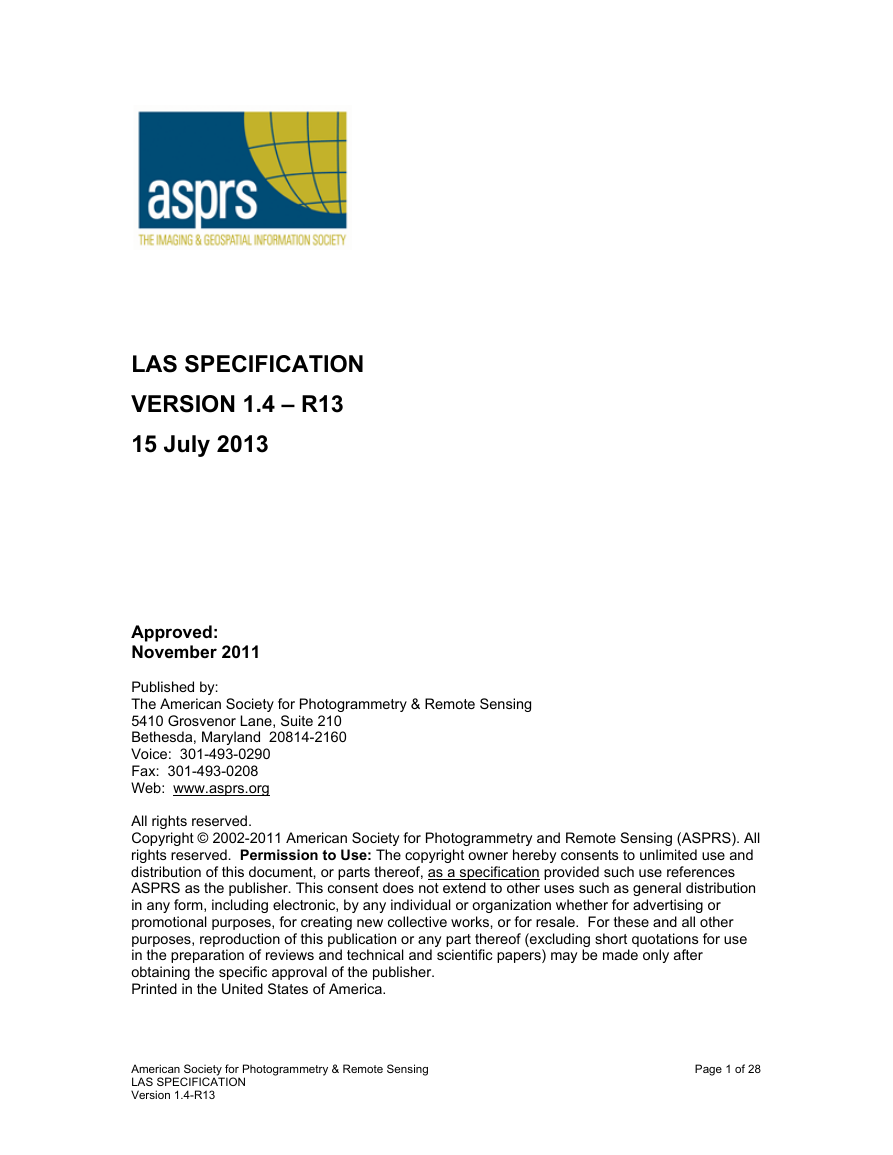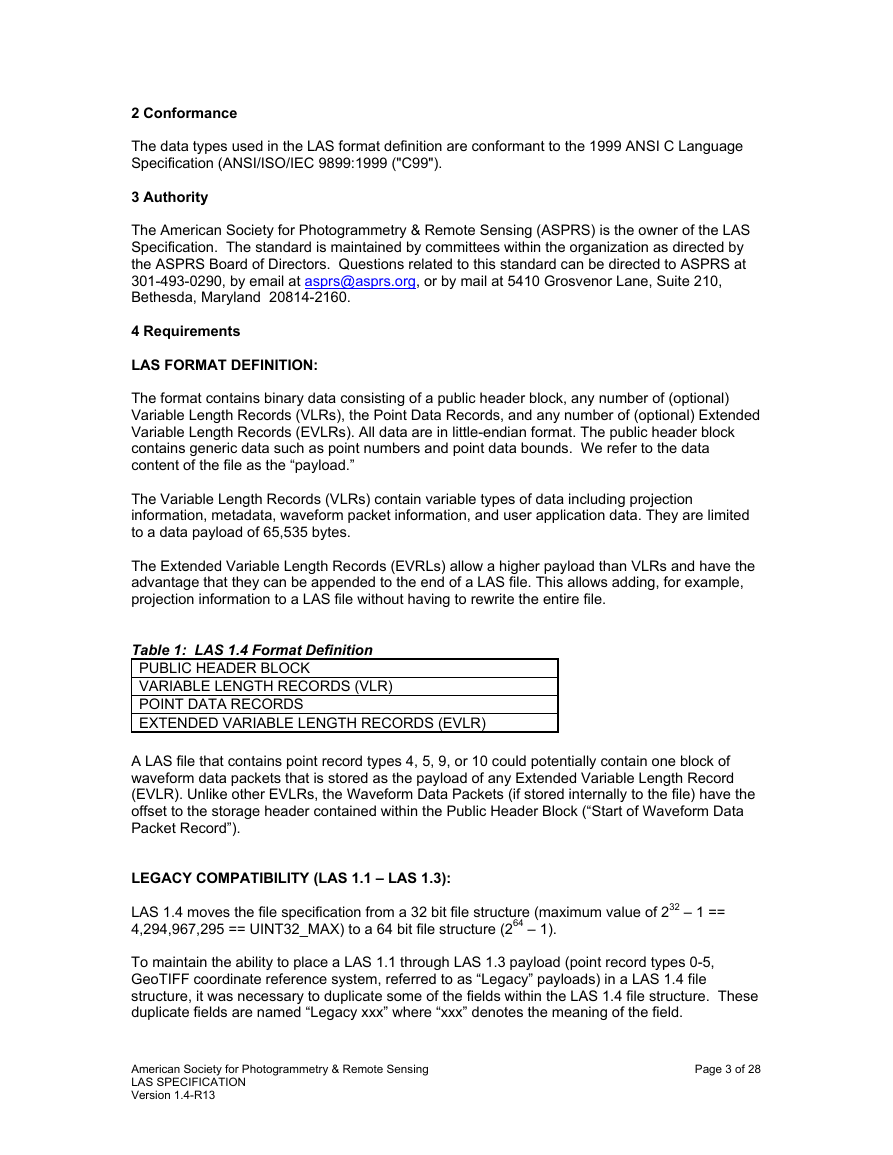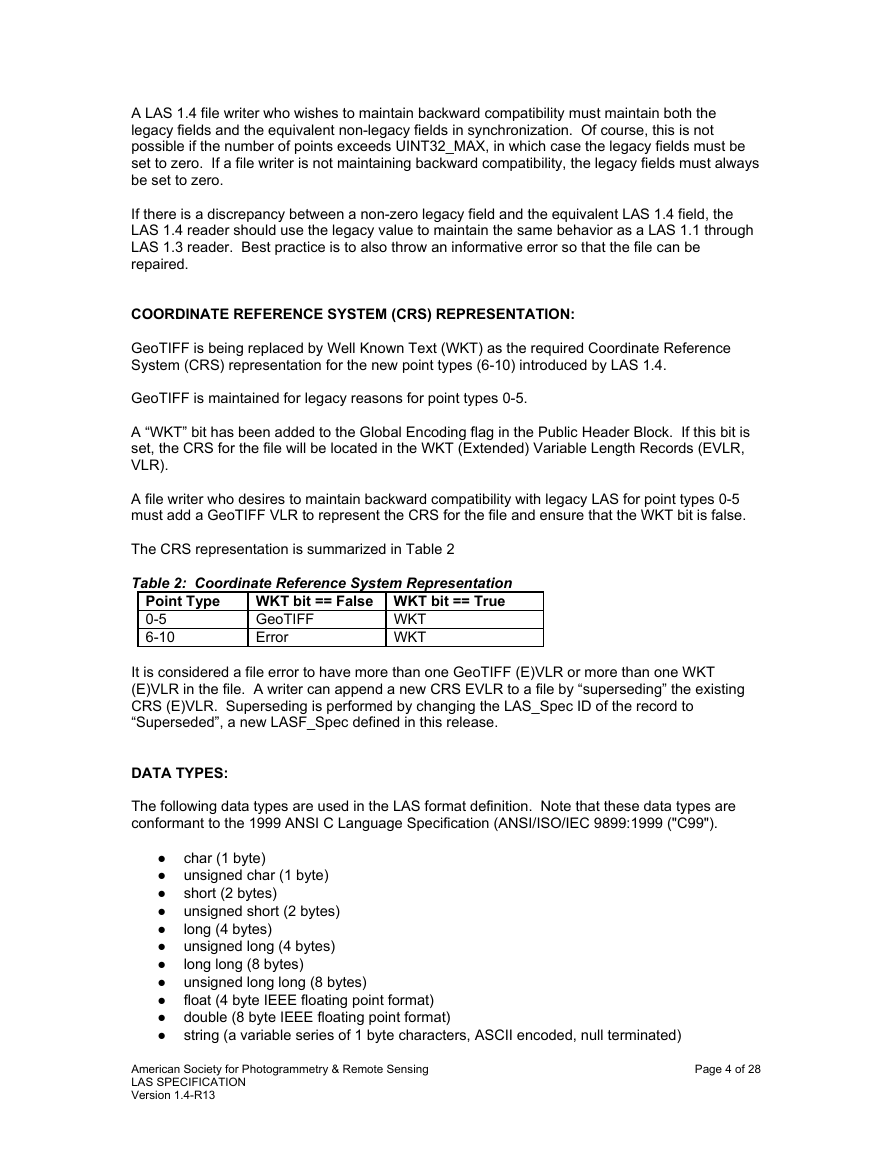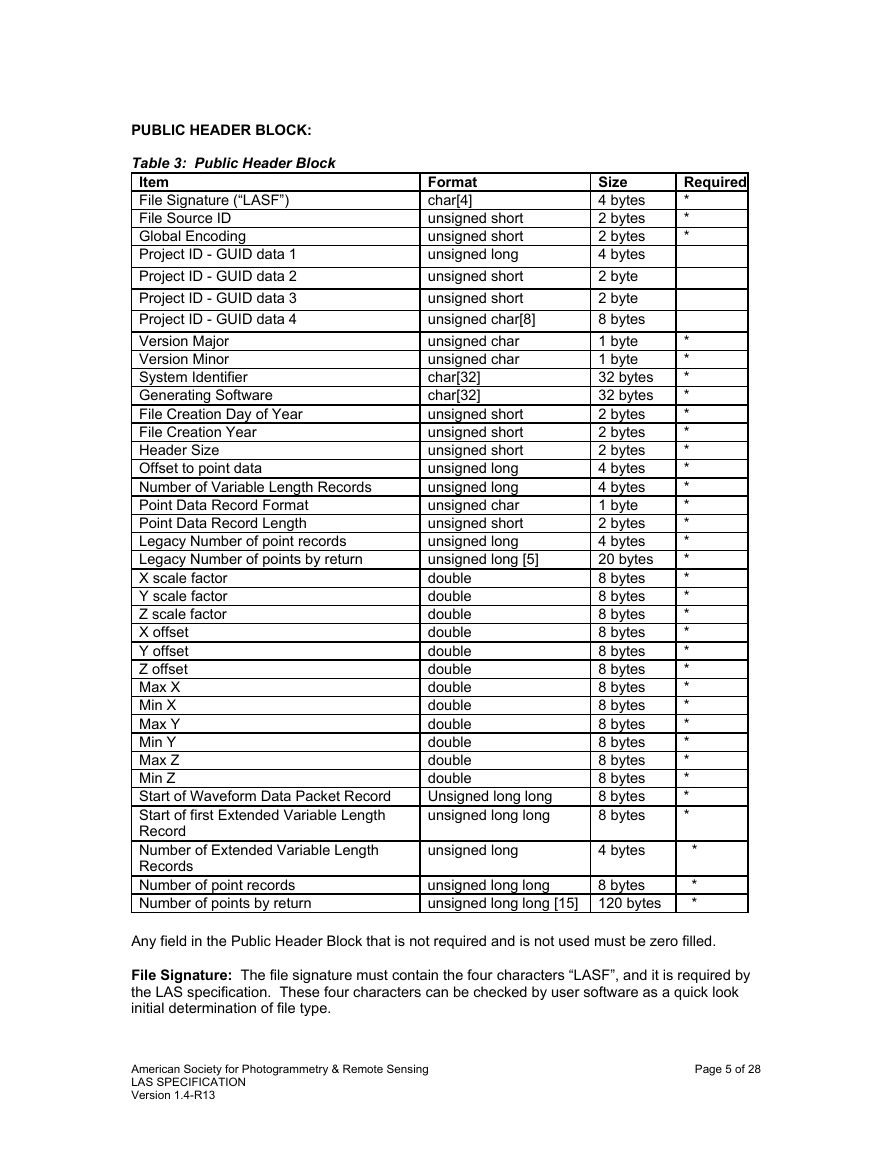Open Geospatial Consortium
Submission Date: 2017-06-27
Approval Date: 2017-10-02
Publication Date: 2018-03-01
External identifier of this OGC® document: http://www.opengis.net/doc/CS/las/1.4
Internal reference number of this OGC® document: 17-030r1
Version: 1.4
Category: OGC® Community Standard
Editor: ASPRS
LAS Specification 1.4
OGC Community Standard
Copyright notice
Copyright © 2018 Open Geospatial Consortium
To obtain additional rights of use, visit http://www.opengeospatial.org/legal/.
Warning
This document is an OGC Member endorsed international Community standard. This
Community standard was developed outside of the OGC and the originating party may
continue to update their work; however, this document is fixed in content.
This document is available on a royalty free, non-discriminatory basis. Recipients of this
document are invited to submit, with their comments, notification of any relevant patent
rights of which they are aware and to provide supporting documentation.
Document type:
Document subtype:
Document stage:
Document language: English
OGC® Community Standard
Approved for Public Release
1
Copyright © 2018 Open Geospatial Consortium
�
License Agreement
Permission is hereby granted by the Open Geospatial Consortium, ("Licensor"), free of charge and subject to the terms set forth
below, to any person obtaining a copy of this Intellectual Property and any associated documentation, to deal in the Intellectual
Property without restriction (except as set forth below), including without limitation the rights to implement, use, copy, modify,
merge, publish, distribute, and/or sublicense copies of the Intellectual Property, and to permit persons to whom the Intellectual
Property is furnished to do so, provided that all copyright notices on the intellectual property are retained intact and that each person
to whom the Intellectual Property is furnished agrees to the terms of this Agreement.
If you modify the Intellectual Property, all copies of the modified Intellectual Property must include, in addition to the above
copyright notice, a notice that the Intellectual Property includes modifications that have not been approved or adopted by
LICENSOR.
THIS LICENSE IS A COPYRIGHT LICENSE ONLY, AND DOES NOT CONVEY ANY RIGHTS UNDER ANY PATENTS
THAT MAY BE IN FORCE ANYWHERE IN THE WORLD.
THE INTELLECTUAL PROPERTY IS PROVIDED "AS IS", WITHOUT WARRANTY OF ANY KIND, EXPRESS OR
IMPLIED, INCLUDING BUT NOT LIMITED TO THE WARRANTIES OF MERCHANTABILITY, FITNESS FOR A
PARTICULAR PURPOSE, AND NONINFRINGEMENT OF THIRD PARTY RIGHTS. THE COPYRIGHT HOLDER OR
HOLDERS INCLUDED IN THIS NOTICE DO NOT WARRANT THAT THE FUNCTIONS CONTAINED IN THE
INTELLECTUAL PROPERTY WILL MEET YOUR REQUIREMENTS OR THAT THE OPERATION OF THE INTELLECTUAL
PROPERTY WILL BE UNINTERRUPTED OR ERROR FREE. ANY USE OF THE INTELLECTUAL PROPERTY SHALL BE
MADE ENTIRELY AT THE USER’S OWN RISK. IN NO EVENT SHALL THE COPYRIGHT HOLDER OR ANY
CONTRIBUTOR OF INTELLECTUAL PROPERTY RIGHTS TO THE INTELLECTUAL PROPERTY BE LIABLE FOR ANY
CLAIM, OR ANY DIRECT, SPECIAL, INDIRECT OR CONSEQUENTIAL DAMAGES, OR ANY DAMAGES WHATSOEVER
RESULTING FROM ANY ALLEGED INFRINGEMENT OR ANY LOSS OF USE, DATA OR PROFITS, WHETHER IN AN
ACTION OF CONTRACT, NEGLIGENCE OR UNDER ANY OTHER LEGAL THEORY, ARISING OUT OF OR IN
CONNECTION WITH THE IMPLEMENTATION, USE, COMMERCIALIZATION OR PERFORMANCE OF THIS
INTELLECTUAL PROPERTY.
This license is effective until terminated. You may terminate it at any time by destroying the Intellectual Property together with all
copies in any form. The license will also terminate if you fail to comply with any term or condition of this Agreement. Except as
provided in the following sentence, no such termination of this license shall require the termination of any third party end-user
sublicense to the Intellectual Property which is in force as of the date of notice of such termination. In addition, should the Intellectual
Property, or the operation of the Intellectual Property, infringe, or in LICENSOR’s sole opinion be likely to infringe, any patent,
copyright, trademark or other right of a third party, you agree that LICENSOR, in its sole discretion, may terminate this license
without any compensation or liability to you, your licensees or any other party. You agree upon termination of any kind to destroy or
cause to be destroyed the Intellectual Property together with all copies in any form, whether held by you or by any third party.
Except as contained in this notice, the name of LICENSOR or of any other holder of a copyright in all or part of the Intellectual
Property shall not be used in advertising or otherwise to promote the sale, use or other dealings in this Intellectual Property without
prior written authorization of LICENSOR or such copyright holder. LICENSOR is and shall at all times be the sole entity that may
authorize you or any third party to use certification marks, trademarks or other special designations to indicate compliance with any
LICENSOR standards or specifications. This Agreement is governed by the laws of the Commonwealth of Massachusetts. The
application to this Agreement of the United Nations Convention on Contracts for the International Sale of Goods is hereby expressly
excluded. In the event any provision of this Agreement shall be deemed unenforceable, void or invalid, such provision shall be
modified so as to make it valid and enforceable, and as so modified the entire Agreement shall remain in full force and effect. No
decision, action or inaction by LICENSOR shall be construed to be a waiver of any rights or remedies available to it.
2
Copyright © 2018 Open Geospatial Consortium
�
NOTES:
The Open Geospatial Consortium (OGC) endorses LAS 1.4 as a Community standard.
The NOTES below provide clarification to the LAS 1.4 specification document for the
benefit of users of the OGC endorsed version of LAS 1.4.
1. The following normative references are included in the document.
a. ANSI: [INCITS/ISO/IEC 9899:1999] 1999 ANSI C Language
Specification,
http://webstore.ansi.org/RecordDetail.aspx?sku=INCITS%2fISO%2fIEC
+9899-1999+(R2005), 2005.
b. OGC: [OGC 01-009] OpenGIS Coordinate Transformation Service
Implementation Specification Revision 1.00, 2001.
c. Ritter, N and Ruth, M.: GeoTIFF Format Specification,
http://web.archive.org/web/20160403164508/http://www.remotesensing.o
rg/geotiff/spec/geotiffhome.html, 2000.
2. The OGC Architecture Board (OAB) recommends that future versions of LAS
include reference to the latest version of the OGC Well-known text representation
of coordinate reference systems (WKT CRS) standard.
a. OGC: [OGC 12-063r5] Geographic information - Well-known text
representation of coordinate reference systems, 2015.
3. The OAB also recommends that future work consider use of multipoint coverages
4. It is clarified that this version of the LAS 1.4 specification does not include
as a valid encoding.
compression.
3
Copyright © 2018 Open Geospatial Consortium
�
LAS SPECIFICATION
VERSION 1.4 – R13
15 July 2013
Approved:
November 2011
Published by:
The American Society for Photogrammetry & Remote Sensing
5410 Grosvenor Lane, Suite 210
Bethesda, Maryland 20814-2160
Voice: 301-493-0290
Fax: 301-493-0208
Web: www.asprs.org
All rights reserved.
Copyright © 2002-2011 American Society for Photogrammetry and Remote Sensing (ASPRS). All
rights reserved. Permission to Use: The copyright owner hereby consents to unlimited use and
distribution of this document, or parts thereof, as a specification provided such use references
ASPRS as the publisher. This consent does not extend to other uses such as general distribution
in any form, including electronic, by any individual or organization whether for advertising or
promotional purposes, for creating new collective works, or for resale. For these and all other
purposes, reproduction of this publication or any part thereof (excluding short quotations for use
in the preparation of reviews and technical and scientific papers) may be made only after
obtaining the specific approval of the publisher.
Printed in the United States of America.
American Society for Photogrammetry & Remote Sensing
LAS SPECIFICATION
Version 1.4-R13
Page 1 of 28
�
REVISION HISTORY
R11 - Approved Version (Nov 2011)
R12 - Errata (June 2012) - Typographical Corrections
Corrected Public Header size in descriptive paragraph to 375 bytes
Corrected two instances of Scan Angle Rank from "Unsigned Char" to "Char"
R13 - Added Domain Profile Section (July 2013)
LAS FORMAT VERSION 1.4:
1 Purpose, scope, and applicability
The LAS file is intended to contain LIDAR (or other) point cloud data records. The data will
generally be put into this format from software (e.g. provided by LIDAR hardware vendors) which
combines GPS, IMU, and laser pulse range data to produce X, Y, and Z point data. The intention
of the data format is to provide an open format that allows different LIDAR hardware and software
tools to output data in a common format.
This document reflects the fourth revision of the LAS format specification since its initial version
1.0 release.
THE ADDITIONS OF LAS 1.4 INCLUDE:
Backward compatibility with LAS 1.1 – LAS 1.3 when payloads consist of only legacy
content
LAS 1.4 Mode which supports
o Extension of offsets and field sizes to support full 64 bit
o Support for up to 15 returns per outgoing pulse
o Extension of the Point Class field to support 256 classes
o Definition of several new ASPRS standard classes
o Extension of the Scan Angle field to 2 bytes to support finer angle resolution
o Addition of a Sensor Channel bit field to support mobile mapping systems
o Addition of Well Known Text (WKT) definitions for Coordinate Reference
o Addition of an Overlap bit to allow indicating pulses in the overlap region while
o Addition of an (optional) Extra Byte Variable Length Record to describe "extra
maintaining the class definition
Systems
bytes" stored with each point
Other minor changes
o Added definitions for “LAS Domain Profile” and “LAS Domain Profile Description”
American Society for Photogrammetry & Remote Sensing
LAS SPECIFICATION
Version 1.4-R13
Page 2 of 28
�
2 Conformance
The data types used in the LAS format definition are conformant to the 1999 ANSI C Language
Specification (ANSI/ISO/IEC 9899:1999 ("C99").
3 Authority
The American Society for Photogrammetry & Remote Sensing (ASPRS) is the owner of the LAS
Specification. The standard is maintained by committees within the organization as directed by
the ASPRS Board of Directors. Questions related to this standard can be directed to ASPRS at
301-493-0290, by email at asprs@asprs.org, or by mail at 5410 Grosvenor Lane, Suite 210,
Bethesda, Maryland 20814-2160.
4 Requirements
LAS FORMAT DEFINITION:
The format contains binary data consisting of a public header block, any number of (optional)
Variable Length Records (VLRs), the Point Data Records, and any number of (optional) Extended
Variable Length Records (EVLRs). All data are in little-endian format. The public header block
contains generic data such as point numbers and point data bounds. We refer to the data
content of the file as the “payload.”
The Variable Length Records (VLRs) contain variable types of data including projection
information, metadata, waveform packet information, and user application data. They are limited
to a data payload of 65,535 bytes.
The Extended Variable Length Records (EVRLs) allow a higher payload than VLRs and have the
advantage that they can be appended to the end of a LAS file. This allows adding, for example,
projection information to a LAS file without having to rewrite the entire file.
Table 1: LAS 1.4 Format Definition
PUBLIC HEADER BLOCK
VARIABLE LENGTH RECORDS (VLR)
POINT DATA RECORDS
EXTENDED VARIABLE LENGTH RECORDS (EVLR)
A LAS file that contains point record types 4, 5, 9, or 10 could potentially contain one block of
waveform data packets that is stored as the payload of any Extended Variable Length Record
(EVLR). Unlike other EVLRs, the Waveform Data Packets (if stored internally to the file) have the
offset to the storage header contained within the Public Header Block (“Start of Waveform Data
Packet Record”).
LEGACY COMPATIBILITY (LAS 1.1 – LAS 1.3):
LAS 1.4 moves the file specification from a 32 bit file structure (maximum value of 232 – 1 ==
4,294,967,295 == UINT32_MAX) to a 64 bit file structure (264 – 1).
To maintain the ability to place a LAS 1.1 through LAS 1.3 payload (point record types 0-5,
GeoTIFF coordinate reference system, referred to as “Legacy” payloads) in a LAS 1.4 file
structure, it was necessary to duplicate some of the fields within the LAS 1.4 file structure. These
duplicate fields are named “Legacy xxx” where “xxx” denotes the meaning of the field.
American Society for Photogrammetry & Remote Sensing
LAS SPECIFICATION
Version 1.4-R13
Page 3 of 28
�
A LAS 1.4 file writer who wishes to maintain backward compatibility must maintain both the
legacy fields and the equivalent non-legacy fields in synchronization. Of course, this is not
possible if the number of points exceeds UINT32_MAX, in which case the legacy fields must be
set to zero. If a file writer is not maintaining backward compatibility, the legacy fields must always
be set to zero.
If there is a discrepancy between a non-zero legacy field and the equivalent LAS 1.4 field, the
LAS 1.4 reader should use the legacy value to maintain the same behavior as a LAS 1.1 through
LAS 1.3 reader. Best practice is to also throw an informative error so that the file can be
repaired.
COORDINATE REFERENCE SYSTEM (CRS) REPRESENTATION:
GeoTIFF is being replaced by Well Known Text (WKT) as the required Coordinate Reference
System (CRS) representation for the new point types (6-10) introduced by LAS 1.4.
GeoTIFF is maintained for legacy reasons for point types 0-5.
A “WKT” bit has been added to the Global Encoding flag in the Public Header Block. If this bit is
set, the CRS for the file will be located in the WKT (Extended) Variable Length Records (EVLR,
VLR).
A file writer who desires to maintain backward compatibility with legacy LAS for point types 0-5
must add a GeoTIFF VLR to represent the CRS for the file and ensure that the WKT bit is false.
The CRS representation is summarized in Table 2
Table 2: Coordinate Reference System Representation
Point Type
0-5
6-10
WKT bit == False WKT bit == True
GeoTIFF
Error
WKT
WKT
It is considered a file error to have more than one GeoTIFF (E)VLR or more than one WKT
(E)VLR in the file. A writer can append a new CRS EVLR to a file by “superseding” the existing
CRS (E)VLR. Superseding is performed by changing the LAS_Spec ID of the record to
“Superseded”, a new LASF_Spec defined in this release.
DATA TYPES:
The following data types are used in the LAS format definition. Note that these data types are
conformant to the 1999 ANSI C Language Specification (ANSI/ISO/IEC 9899:1999 ("C99").
long (4 bytes)
● char (1 byte)
● unsigned char (1 byte)
● short (2 bytes)
● unsigned short (2 bytes)
●
● unsigned long (4 bytes)
●
● unsigned long long (8 bytes)
●
● double (8 byte IEEE floating point format)
● string (a variable series of 1 byte characters, ASCII encoded, null terminated)
float (4 byte IEEE floating point format)
long long (8 bytes)
American Society for Photogrammetry & Remote Sensing
LAS SPECIFICATION
Version 1.4-R13
Page 4 of 28
�
PUBLIC HEADER BLOCK:
Table 3: Public Header Block
Item
File Signature (“LASF”)
File Source ID
Global Encoding
Project ID - GUID data 1
Project ID - GUID data 2
Project ID - GUID data 3
Project ID - GUID data 4
Version Major
Version Minor
System Identifier
Generating Software
File Creation Day of Year
File Creation Year
Header Size
Offset to point data
Number of Variable Length Records
Point Data Record Format
Point Data Record Length
Legacy Number of point records
Legacy Number of points by return
X scale factor
Y scale factor
Z scale factor
X offset
Y offset
Z offset
Max X
Min X
Max Y
Min Y
Max Z
Min Z
Start of Waveform Data Packet Record
Start of first Extended Variable Length
Record
Number of Extended Variable Length
Records
Number of point records
Number of points by return
Any field in the Public Header Block that is not required and is not used must be zero filled.
File Signature: The file signature must contain the four characters “LASF”, and it is required by
the LAS specification. These four characters can be checked by user software as a quick look
initial determination of file type.
American Society for Photogrammetry & Remote Sensing
LAS SPECIFICATION
Version 1.4-R13
Page 5 of 28
Format
char[4]
unsigned short
unsigned short
unsigned long
unsigned short
unsigned short
unsigned char[8]
unsigned char
unsigned char
char[32]
char[32]
unsigned short
unsigned short
unsigned short
unsigned long
unsigned long
unsigned char
unsigned short
unsigned long
unsigned long [5]
double
double
double
double
double
double
double
double
double
double
double
double
Unsigned long long
unsigned long long
Size
4 bytes
2 bytes
2 bytes
4 bytes
2 byte
2 byte
8 bytes
1 byte
1 byte
32 bytes
32 bytes
2 bytes
2 bytes
2 bytes
4 bytes
4 bytes
1 byte
2 bytes
4 bytes
20 bytes
8 bytes
8 bytes
8 bytes
8 bytes
8 bytes
8 bytes
8 bytes
8 bytes
8 bytes
8 bytes
8 bytes
8 bytes
8 bytes
8 bytes
Required
*
*
*
*
*
*
*
*
*
*
*
*
*
*
*
*
*
*
*
*
*
*
*
*
*
*
*
*
*
*
unsigned long
4 bytes
*
unsigned long long
unsigned long long [15] 120 bytes
8 bytes
*
*
�
















 2023年江西萍乡中考道德与法治真题及答案.doc
2023年江西萍乡中考道德与法治真题及答案.doc 2012年重庆南川中考生物真题及答案.doc
2012年重庆南川中考生物真题及答案.doc 2013年江西师范大学地理学综合及文艺理论基础考研真题.doc
2013年江西师范大学地理学综合及文艺理论基础考研真题.doc 2020年四川甘孜小升初语文真题及答案I卷.doc
2020年四川甘孜小升初语文真题及答案I卷.doc 2020年注册岩土工程师专业基础考试真题及答案.doc
2020年注册岩土工程师专业基础考试真题及答案.doc 2023-2024学年福建省厦门市九年级上学期数学月考试题及答案.doc
2023-2024学年福建省厦门市九年级上学期数学月考试题及答案.doc 2021-2022学年辽宁省沈阳市大东区九年级上学期语文期末试题及答案.doc
2021-2022学年辽宁省沈阳市大东区九年级上学期语文期末试题及答案.doc 2022-2023学年北京东城区初三第一学期物理期末试卷及答案.doc
2022-2023学年北京东城区初三第一学期物理期末试卷及答案.doc 2018上半年江西教师资格初中地理学科知识与教学能力真题及答案.doc
2018上半年江西教师资格初中地理学科知识与教学能力真题及答案.doc 2012年河北国家公务员申论考试真题及答案-省级.doc
2012年河北国家公务员申论考试真题及答案-省级.doc 2020-2021学年江苏省扬州市江都区邵樊片九年级上学期数学第一次质量检测试题及答案.doc
2020-2021学年江苏省扬州市江都区邵樊片九年级上学期数学第一次质量检测试题及答案.doc 2022下半年黑龙江教师资格证中学综合素质真题及答案.doc
2022下半年黑龙江教师资格证中学综合素质真题及答案.doc